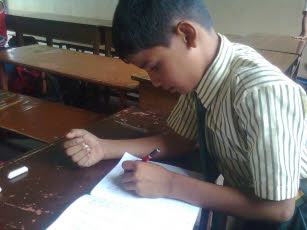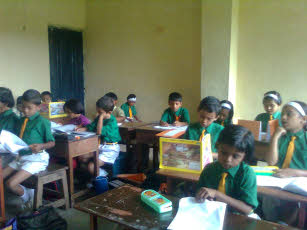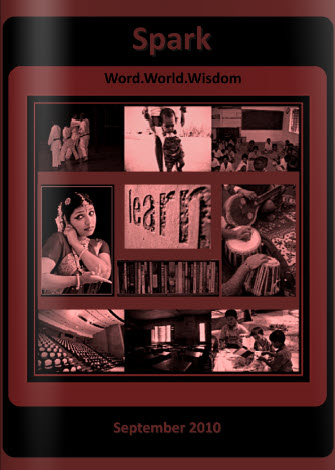by Meera Sivakumar
[box]What does it mean to teach a bunch of kids coming from low-income backgrounds? Meera Sivakumar shares her thoughts on this transformational experience. Text and Pictures by Meera Sivakumar.[/box] [box type=”bio”]Meera Sivakumar is a Teach For India Fellow. Teach For India (TFI) is a movement that aims to end education inequity in India and provide excellent education to all children. Every year, TFI places outstanding youngsters including college graduates and professionals into low income municipal and private schools as teachers. To know more about Teach For India, visit http://teachforindia.org. Find out more about Meera’s experiences with TFI at her blog.[/box]At the end of the first week of school, 40 Teach For India Fellows sit in a circle. Rebecca Noecker, a Teach For America alumna and one of the Program Managers of the cohort, starts the discussion. She asks us to share the lowest point in our week. Satish*, a very quiet young man, speaks with a resigned smile, “I have 120 students in my class. I don’t know what a low point is.” Poornima*, an otherwise peppy 21- year old engineering graduate says, in frustration, “I have no classroom. The one spare room in my school is used to store rice grains. My class sits on the corridor.” Keerti* follows up with, “My 8- year-old son feels bad that I don’t spend enough time with him.”
Teach For India never says it is going to be easy. When I met Shaheen Mistri (the CEO of Teach for India and founder of Akanksha Foundation, a non-profit organization that works primarily in the education space) for a chat over coffee, even before I applied, her first words about the fellowship were, “You should be prepared for intense personal transformation.”
“This, my dear Fellows, is what we were referring to when we asked ‘Are you ready for a challenge?’ “, says Rebecca. There are slow nods of comprehension all around. It is all beginning to make sense. Finally.
Teach For India, started in 2008, is a leadership program based on the tried and tested Teach For America model. Outstanding college graduates and working professionals are recruited to commit two years to teaching in Government and low income private schools. The application process is grueling with several written essays and a day-long assessment process that tests critical thinking, team work, ability to plan and teach along with commitment and prior leadership experience. In 2010, one in seven applicants got in.
The program is selective for a reason. Teach For India pushes one headlong into the ‘challenge’ from Day One. The Fellowship starts with a five-week training boot camp. Fellows bond over 16-hour work days which include community visits, out-of-the-box assignments to push one out of her/his comfort zone, reflections and four weeks of observing teaching in a summer school. What makes Teach For India different is their approach to tackling the huge problem of achievement gap that exists in India. The Fellows, during the summer institute, are introduced to the ‘Teaching As Leadership’ model – they are taught to set big goals, invest in stakeholders, plan purposefully, execute effectively, continually increase effectiveness and work relentlessly. The classroom is now akin to an ailing company that needs to be turned around.
According to me, the experience is truly unique and personally transformative for a number of reasons. The Fellows deal with children. The Fellows come from backgrounds and careers very different from the lives of the children in the class. The problems that the Fellow encounters in the classroom and in the lives of the children are very diverse; there is no one tailor-made solution. In order to successfully tackle and solve some of these problems and to ensure that the class achieves its year-end goal, the Fellow is required to develop professional skills like clear communication, resourcefulness and critical thinking, and more importantly, deeply personal qualities like empathy, integrity, sense of possibility and reflection.
When I entered the 2nd grade classroom in Rashmi English Medium School (a low income private school in Pune) that I am to be working in for the rest of the year, I was prepared for some things and completely unprepared for others. I had a behaviour plan to ensure I could handle thirty 7-year-olds. I had lesson plans to ensure they learnt what they had to. I had learning aids to make the class engaging and to cater to their wavering attention spans. However I was not prepared for leaking roofs, wet and soggy classrooms, frogs that jumped out of corners and other interruptions.
Certain preconceived notions were shattered. For example, most parents have invested in and are interested in their children’s education. They are hard working, with most of them working two to three jobs a day. They do not have the time or the energy to monitor their children’s day-to-day lessons.
A few other preconceived notions were reinforced. For example, there is some general apathy among teachers. There is a lot of emphasis on bureaucracy and red tapism in the school that makes it seem like an inefficient Government office. There is a culture of learning that emphasizes more on content than skills. Children (and parents!) expect to be tested on questions “from the workbook.” How does one work on changing these mindsets?
Academically, the challenge is enormous. Diagnostics made at the start of the academic year reveal that most students in my 2nd grade class are at least one year behind in their Math skills and two years or more in their English language skills. Some of them do not know the English alphabet while some others cannot even write their names. The average reading fluency of the class is at four words per minute.
While I plan to accelerate their learning by 1.5 years by end of year one, I encounter problems like my own fledgling teaching skills, lack of enough teaching days and most important of all, the polarized needs in my class for differentiated groups of learners: after all, every child is different.
 In parallel to academic achievement gap, the most challenging and interesting aspect of the classroom experience is the interaction with the children. The student-teacher relationship in primary school extends beyond the transaction of learning and teaching. Teaching the prescribed subjects is relatively easy compared to connecting with the child emotionally. How does one understand and deal with violence and rebellion? How does one take the child into confidence and subtly work on years of pessimistic reinforcement? Being an engineer and having worked as a consultant, and having never interacted with children before, these questions baffled me completely at first. What immensely helped is a visit to their homes and a conversation with their families.
In parallel to academic achievement gap, the most challenging and interesting aspect of the classroom experience is the interaction with the children. The student-teacher relationship in primary school extends beyond the transaction of learning and teaching. Teaching the prescribed subjects is relatively easy compared to connecting with the child emotionally. How does one understand and deal with violence and rebellion? How does one take the child into confidence and subtly work on years of pessimistic reinforcement? Being an engineer and having worked as a consultant, and having never interacted with children before, these questions baffled me completely at first. What immensely helped is a visit to their homes and a conversation with their families.
No other work I have done has made me feel so completely vulnerable. Yet, there are times when the feeling of personal empowerment is overwhelming.
I can see the first two months of the Fellowship already shaping my personality in interesting ways. While organisation skills, time management and resourceful thinking have improved quite quickly, qualities like patience and empathy are making their slow appearance.
I can see the same in my colleagues too. Over two months, Satish* has a co-teacher to help him manage his class which is now sixty in number. Poornima* has convinced her school’s Principal to use the spare room for her class. She is also raising money to build a new classroom, while Keerti* involves her son in her preparations for the class so that he does not feel left out.
With Teach for India, we are learning and transforming too.
*names have been changed
[facebook]share[/facebook] [retweet]tweet[/retweet]





